#Cicindelinae
Text



tiger beetle
2K notes
·
View notes
Text
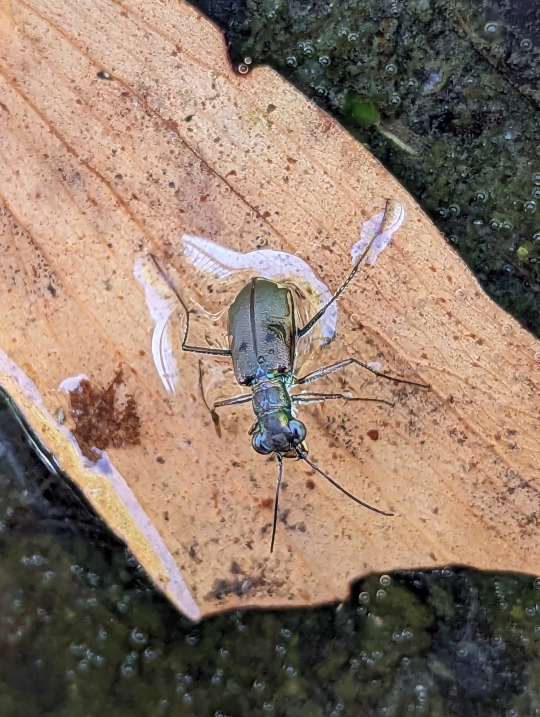



Ground beetle spotted in a puddle.
Found a few this time of year.
04/12/23 - Myriochila semicincta
QLD:WET - Rainforest nursery
#invertblr#invertebrates#Arthropoda#Arthropods#bugblr#bugs#bug#bugs tw#insects#insectblr#insecta#insect#insects tw#entomology#Myriochila semicincta#Cicindelinae#Tiger Beetles#Carabidae#Ground Beetles#beetles#coleoptera#gifs
37 notes
·
View notes
Photo
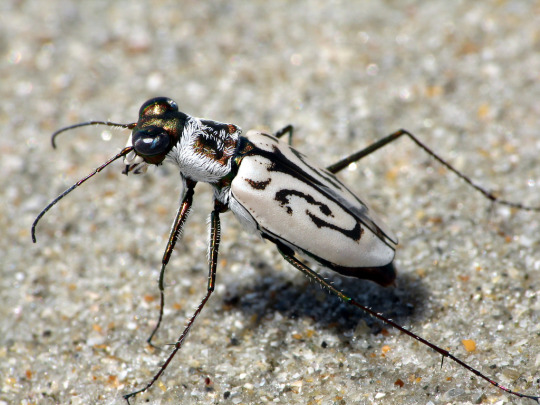



Eastern beach tiger beetle, Habroscelimorpha dorsalis, Cicindelinae
Found in the eastern and southern coastal United States
Photos 1-2 by Sean McCann, 3 by mhedin, and 4 by tomkennedy
#animals#curators on tumblr#insects#bugs#beetle#ground beetle#tiger beetle#eastern beach tiger beetle#one nice bug
1K notes
·
View notes
Text

✨cool bug facts's✨
Cicindelinae, or the tiger beetle!
They look like a dogbane beetle's lanky cousin who just got his Adam's apple. But he has a good fashion sense, I guess.

The anatomy of these bling-blingy Insects!!!
The fastest species of tiger beetle (Rivacindela hudsoni) can run up to 9 km/h (5.6 mph), which is 125 body lengths per second, and are considered to be the fastest land animal for their size.
Depending on the species, their colors can either be very bright, or completely black. Each species evolved into their colors to match up with their environment.
The larvae have very large, shovel-like heads and a humped back that they use for catching prey by rolling over backwards and catching the prey with their backs. The adults catch prey simply by chasing them.
One of their mandibles is usually around 1 millimeter smaller than the other.
The larvae have a pair of hooks on their abdomen so that they won't be dragged out of their burrow when trying to catch prey.
Their main distinction from ground beetles is that their head are wider than their thorax.
They fully develop between 1 to 4 years old, depending on their environment, species, and food supply.
The won't emerge after completing their developmental cycle for 3 days in order for their exoskeleton to harden, but when they emerge their exoskeletons are still a little soft and they have lighter colors, making them a very easy target for predators.
They can release several poisons when threatened, including cyanide. They can't produce enough poison to harm a human, but may be able to kill a small insect or spider (or just a small animal in general). One species can emit a poison that smells like bubblegum.
Diet.
The larvae's usual meals consist of smaller insects, such as ants, beetles, caterpillars, flies, grasshopper nymphs, small terrestrial crustaceans, and even small spiders.
The adults don't eat as much as the larvae, but they do eat the same things, this time being able to chase after their prey.
Behavior.
When they're chasing their prey, they run for a few moments, and then stop, and then start running again, and repeat. This is due to the speed that they run at being too fast for their eyes to properly process visual stimuli.
The females burrow into the sand to lay their eggs, and when their larvae hatch they begin to dig deeper into the burrow their mother made for them by putting their head's shape to good use and shoveling further into the ground, and it eventually reaches about 30 to 60 centimeters (1 to 2 feet) deep.
In order to dissuade other suitors, males will clamp their mandibles around their mates thorax and ride on top of them to show that they are taken.
The larvae wait at the entrance of their burrow until an insect or spider walks by and leaps at them to try and catch them. Adult tiger beetles stalk their prey like an actual tiger and then run or fly at them, usually not giving them enough time to react before catching them.
They can hear the echolocation of bats, and will turn around and try to fly away while making a noise back to the bats to try and signal that they're poisonous.
Habitat
They live in almost every part of the world.
Most species prefer to live on any surface with sand, or sunny surfaces, as they prefer heat like most beetles.
Cool fact that didn't fit into these categories.
Their larvae are sometimes called 'doodlebugs', although the name is more commonly associated with the antlion.
#bug#insect#beetle#tiger beetle#entomology#coleopterology#bugblr#cool bugs#cool bug facts#cool bug's#cool bug fact's
53 notes
·
View notes
Photo

Larva de Coleoptera de la subfamilia Cicindelinae (Familia Carabidae). Estas larvas viven en un orificio perpendicular a la superficie del suelo donde esperan el paso de una presa. #entomología #entomology #entomologist #arthopodos #insect #Venezuela #coleoptera #carabidae #cicindelido #cincindelinae #depredador #depredation #depredadores #depredator (at La Peñita, Aragua, Venezuela) https://www.instagram.com/p/Ciguv9yN9rw/?igshid=NGJjMDIxMWI=
#entomología#entomology#entomologist#arthopodos#insect#venezuela#coleoptera#carabidae#cicindelido#cincindelinae#depredador#depredation#depredadores#depredator
3 notes
·
View notes
Text
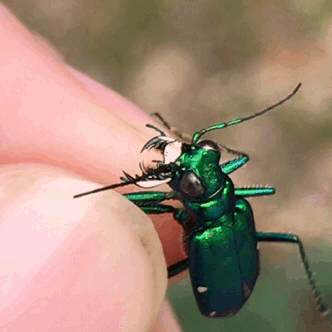
UNHAND ME
829 notes
·
View notes
Text
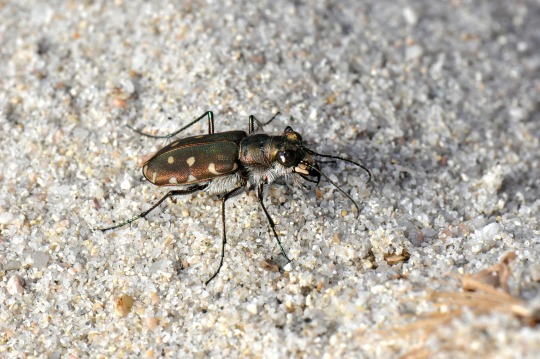
Calomera littoralis / la Cicindèle des plages.
Août 2021.
Serra di Ferro, Corse, France
3 notes
·
View notes
Photo
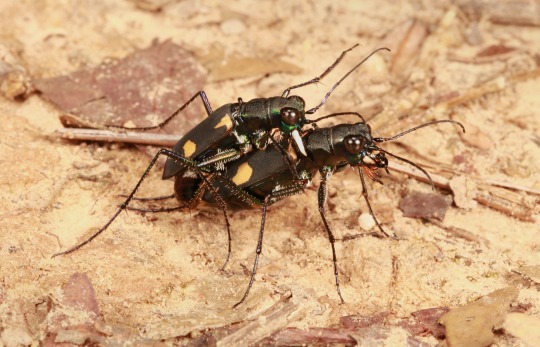
Tiger Beetles (Calochroa salvazai, Cicindelinae, Carabidae)
Once a male tiger beetle has selected his mate, he claims her and deters rival matings by clinging to her thorax with his ample jaws.
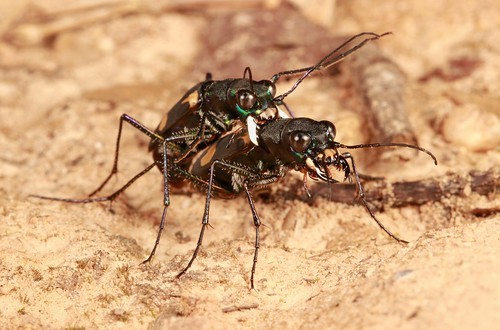
by Sinobug (itchydogimages) on Flickr.
Pu’er, Yunnan, China
See more Chinese beetles on my Flickr site HERE...
#insect#macro#China#Yunnan#itchydogimages#Sinobug#entomology#beetle#tiger beetle#Coleoptera#Carabidae#Cicindelinae
59 notes
·
View notes
Text
#1634 - Subfam. Cicindelinae - Tiger Beetle Larva

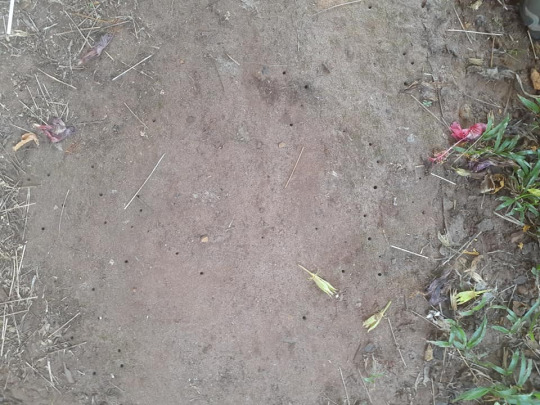
Photo by Peter Hayhoa in the Tiwi Islands, north of Darwin.
The records for tiger beetles up that way include Cicindela (Archidela) darwini (which makes sense) and Australicapitona australasiae (also a good name), but since I can’t find pics of the larvae of either, I’m not going to go past subfamily. Not least since they were demoted to a subfamily of the Carabidae and the published literature on their taxonomy is an appalling mess.
Tiger Beetles are highly predatory Ground Beetles, with large eyes and, usually, long legs. They move so quickly that they can’t process what they’re seeing without stopping to think, leading to a distinctive dash-and-pause run as they pursue prey and recalculate which way to run. Wisely, they hold their antennae out in front of them as they sprint, to avoid running into obstacles at top speed.
Tiger beetles larvae, on the other hand, live in cylindrical burrows up to a meter deep. They are large-headed, fearsomely jawed, and hump-backed, and use their humpbacks to grip the sides of their tunnels as the lunge out at any passing prey. While they wait, their heads fit snuggly into the burrow, and their eyes are positioned to peer in all directions.
Some tropical species are arboreal, but most live on the ground along shorelines, on sand dunes, around dry lakebeds and on clay banks or woodland paths, being particularly fond of sandy surfaces as in the photo here. That said, being unearthed from their burrow is a problem, so at least one beach-dwelling species, Cicindela dorsalis media, will flip intself into a circle and roll off across the beach at high speed, driven by the wind.
12 notes
·
View notes
Photo

Puritan Tiger Beetles, ‘Vicious Predators,’ May Soon Hunt Again - The New York Times
In row upon row, 436 tiny larvae are presumably fast asleep now, a few months after they were tucked inches deep into trenches dug along the sandy banks of the Connecticut River.
The nestled larvae represent the last chance for one of New England’s most endangered species, the Puritan tiger beetle — an insect tiny enough to fit on the pad of a thumb. The species only exists in small numbers in just two spots here, and another in the Chesapeake Bay area.
“This is it for New England,” said Laura Saucier, a wildlife biologist for the state of Connecticut. “If we lose our population in Connecticut, it’s gone. The stakes are pretty high.”
Granted, the Puritan tiger beetle project — one of the largest insect reintroductions in the country — lacks the emotional appeal of protecting pandas or polar bears. “It’s not fuzzy and has a face only a mother could love, but they’re just so interesting,” Dr. Saucier said. “They’re the top predators in this food web and the food web is down here,” she said, pointing to the sand, “so we don’t know a lot about them.”
But for an ecosystem that runs from the Canadian border to the Long Island Sound, maintaining ecological balance is crucial, said Rodger Gwiazdowski, the entomologist who is leading the project and who has been dreaming for nearly two decades about restoring the Puritan tiger beetle.
The beetles aren’t an obvious missing link in an ecological chain; no other creature is known to have died or flourished as their numbers diminished, as far as Dr. Gwiazdowski knows.
But “they’re part of a healthy river,” he said. “When we see a stretch of healthy river, we see beetles.” So, restoring them should help support the health of New England’s longest river, whose watershed is home to more than 2 million people. “It’s powerfully naïve to think it means nothing” to allow the Puritan tiger beetles to disappear, he said.
#Puritan Tiger Beetle#Ellipsoptera puritana#Ellipsoptera#Cicindelini#Cicindelinae#Carabidae#Adephaga#Coleoptera#Insecta#Hexapoda#Arthropoda#beetle#tiger beetle#insects#endangered#conservation#Connecticut River#Connecticut
15 notes
·
View notes
Photo

Bug of the Day
It’s another Stamp Sunday at BotD! This week, we are featuring a colorful tiger beetle, Chaetodera andriana, on a stamp from the African island of Madagascar. There is not a heck of a lot of information about this species on the internets other than images of this stamp, I think maybe genus Chaetodera was sorted into Cicindela a few years back. If you’re hard core, you may want to learn more from this 2011 article in Insecta Mundi.
#Chaetodera andriana#Cicindelinae#Carabidae#tiger beetle#beetle#insect#stamp#stamps#stamp collecting#Philately#Coleoptera
64 notes
·
View notes
Photo

静かな海岸の波打ち際、ハンミョウの群れ・・・これが撮りたかったので能登半島に来ました。間に合って良かった。 しかし、軽トラのおじさん達の群れも大きく、海岸の虫達は大丈夫なのだろうかと不安にもなりました。 #日本#Japan#石川県#Ishikawaken#昆虫#Insecta #insects#甲虫#鞘翅目 #オサムシ科 #Carabidae#ハンミョウ亜科#Cicindelinae#ハラビロハンミョウ#Chaetodera_angulata_niponensis (能登半島) https://www.instagram.com/p/B2RHtLcAs4r/?igshid=dtskd8qjfc8z
#日本#japan#石川県#ishikawaken#昆虫#insecta#insects#甲虫#鞘翅目#オサムシ科#carabidae#ハンミョウ亜科#cicindelinae#ハラビロハンミョウ#chaetodera_angulata_niponensis
1 note
·
View note
Video
Closer Look por Charles Lam
#Animal#Invertebrate#Arthropod#Insect#Beetle#Ecdysozoa#Hexapoda#Coleoptera#Adephaga#Geadephaga#Caraboidea#Carabidae#Ground Beetle#Cicindelinae#Tiger Beetle#Cicindelini#Cicindela#Cicindela aurulenta#Golden Spotted Tiger Beetle
4 notes
·
View notes
Photo
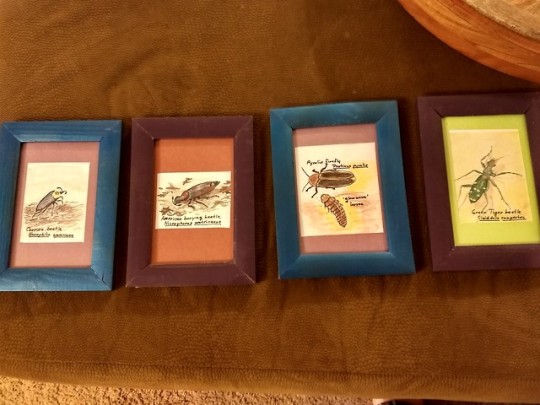
Picked up some cute bug pictures at the Earth day festival today.
#bug#bugs#art#insects#silphidae#lampyridae#cicindelinae#all creepy crawlies get the bug tags#my life
10 notes
·
View notes
Photo

This past Friday I got to spend some more time at the Snow Entomological Museum Collection at the University of Kansas. In addition to some of Crystal Maier’s old specimens I found these extraordinary tiger beetles in the collection. Cicindela chinensis (DeGeer 1774) is a tiger beetle native to Asia. These particular specimens were collected in Japan in the late 1940s.
193 notes
·
View notes


